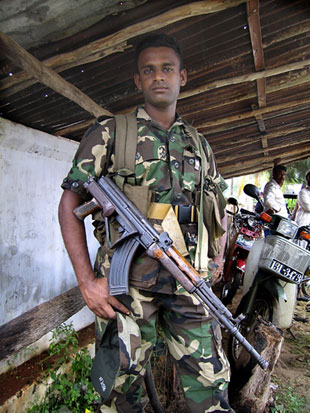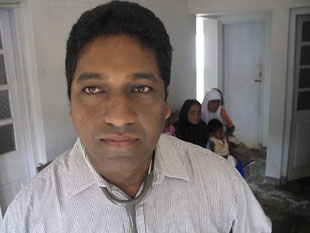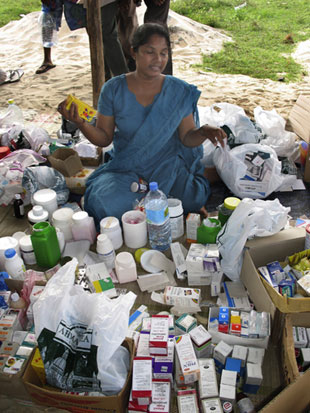TRINCOMALEE — Two weeks in Sri Lanka. Nearly all of what I’ve written, even in my journal, has been for publication. Haven’t had any time to reflect on the personal — which is actually a refreshing change from my normal schedule of 24/7 self-involvement. A disaster like this pulls you out of yourself; your narrow worldview is uprooted, and the focus of your life becomes the lives around you.
On Saturday morning we visit a beach near Kudakally, where the fishermen are working out ways to rebuild their fleet of narrow, brightly painted boats. Each boat employs upwards of 40 men; not to run the boat, but to monitor and pull in the enormous coir nets weighted to the seafloor.
As we’re standing with the Mercy Corps and Sewalanka team, discussing the sort of support they might offer the fishermen and net-makers, one of the men steps forward. He’s wearing a clean white shirt, and resembles — absurdly — a Moslem Walter Matthau. He has no special request; he simply wants us to know that he has lost everything.
“My son, my daughter, my wife, and …” But the fisherman cannot finish his sentence; he breaks down in sobs. Behind me and around me, the other fishermen fight back tears; I succumb. It is another one of those moments when the sheer force of loss hits me like a physical blow. I put myself in this fisherman’s place, and wonder if I — after losing everything that gave my life joy and structure — could begin to rebuild after three short weeks.

During lunch at the Siam View, I ask Dominique Kerr, a member of the French Red Cross team, about the patients in the infirmary.
“We’re not seeing a lot of injuries anymore,” he replies. “Most of what we’re dealing with now is PTSD: Post-Traumatic Stress Disorder.”
What’s interesting, Kerr remarks, is that the men, women, and children all manifest the syndrome with different symptoms.
“For children, the main thing is fear of the sea,” Kerr says. “They won’t go near the water. For women, they can’t sleep. When they come in, they tell us everything is fine — but soon the truth comes out. They are just not sleeping. For men, it is different. They come in, claiming to be sick, and looking sick. But they are not sick; there is nothing physically wrong with them. Then we know it is the post-traumatic stress.”
* * *
Our next destination is the town of Baticalloa, 75 miles to the north — if we can follow the coast. Just above Pottuvil, we pass through the ruins of Komari village. Aside from the cleared road, there are no signs that anything has changed since the tsunami. Walking through the empty place, past broken bicycles and torn Bibles, is like being in a hamlet after the plague. Waves break in the background; the occasional coconut falls to Earth and bursts on the ground. Otherwise, all is silence; an otherworldly quiet that seems to call for an echoing silence.
After exploring Komari, I ask our driver to backtrack half a mile, to the Finnish Red Cross field hospital. The clinic serves the Komari camp, where we recently distributed footballs and Frisbees to the heirs of the ruined village. At the mobile hospital I find Dr. Johannes, a white-haired surgeon who spent much of his career working in Cambodia with victims of the Khmer Rouge.

“Everyone here has post-traumatic stress,” Johannes emphasizes. “Yesterday, for example, a woman came in with all the signs of a gastric ulcer: the kind often created by stress. People are coming in all the time, claiming body pains — but when you look, there’s no cause for it. A man came in with severe pain in his knee; we checked him carefully. Nothing, nothing, nothing. Nonetheless,” he says, “they seem to improve when you examine them, and listen to them.”
That’s because only effective way to treat people for this condition, he claims, is to talk to them. Just having the medical camp present is a comfort — but the main problem is language. “You can bring in as many psychosocial counselors as you like,” says Johannes, “but if you don’t speak their language you can forget it. This, I learned in Cambodia.”
Kids, on the other hand, are more non-verbal. “They respond very well when they are given a doll, or a stuffed animal,” Doctor Johannes observes. “Something they can care about, and protect. It makes them feel stronger, themselves.”
* * *
Our drive up the coast toward Batticaloa is interrupted by numerous detours and back-tracks. We’ll pass through a town, and travel five rough miles up the half-collapsed road, only to find the bridge down. Illustrated with fierce clarity is the sheer breadth of the killer wave. The entire coastline of Sri Lanka is a wreck. Sometimes the damage lies right at the shore, sometimes it extends far inland, but it is nearly universal. Many houses of worship — Buddhist, Hindu, Christian and Moslem — were spared, but not all. Just north of Thirrukovil we find a Hindu temple hit by the tsunami. Colorful statues and bits of paintings lay scattered across the roadside like an exploded bouquet.
It makes me wonder, again, if I would have understood — when the water rushed out, exposing the seabed — what was in store. The truth is, I don’t know. None of us had any sense of what precedes a tsunami, as there haven’t been any during our lifetimes. Disaster movies don’t show the water receding; a huge wave simply rushes in, tossing taxi cabs and billboards down the street. Would I have run out to marvel at the exposed reef, or run in the other direction? There is no way to reckon whether I’d have been saved by my intuition, or killed by my curiosity.
* * *
Batticaloa, about a third of the way up Sri Lanka’s east coast, is the Club Med of the relief world. We spend our single evening in town at Sabharaj -the only open restaurant in Batti, packed with expats. The culture shock nearly does me in. I’d forgotten what a circus the aid world can be, when scores of organizations are jockeying for position for a place within a convoluted, often chaotic environment.
Amid the crowded tables and clouds of cigarette smoke I meet a petite, athletic-looking woman named Isabel. She’s just arrived, charged with directing the French team of Médecins Sans Frontiéres. Isabel is only one day in the country, but she already seems like a victim of relief burn-out.

“We closed our office in Trincomalee yesterday,” she says. “There was nothing for us to do. Even here in Batticaloa, I don’t yet know where we can be of use.” Several days ago, she reminds me, MSF controversially asked (on their website) that people no longer donate money for tsunami relief; there are other global crises with an equal or greater need. Isabel agrees with the statement. She’s fed up with the present situation, with dozens of over-funded relief agencies tripping over each other. They’re duplicating efforts like medical care, she says, while falling short on long-term needs — like rebuilding the economic bedrock of the community.
I sympathize with her frustration. Three weeks after the tsunami, much of the relief community seems in a state of disarray, with less coordination and cooperation than one might expect. Nothing is going to waste — whatever comes in is being distributed — but there’s an inequality of distribution, which can lead to anger or violence. And human resources are being wasted. Doctors are being turned away; groups like MSF are pounding the pavement, looking for places to hang their berets.
* * *
Normally, the 100-mile drive from Batticaloa to Trincomalee takes a few scenic hours; but the seaside route is impassible, and we are forced to traverse two long inland legs, rather than the coastal hypotenuse, of an enormous triangle.
The way is lined with Sri Lanka Army checkpoints, barricades, and spools of razor wire. A placid lagoon is surrounded by an electrified fence. They’re stark reminders that, during the decades before the tsunami, Sri Lanka was already wracked by waves of violence. Even the disaster has not brokered a truce between the Tamil separatist movement and the Sinhalese government. The LTTE, or Tamil Tigers, accuse the government of shortchanging them on relief supplies, and using the situation as an opportunity to infiltrate their operations. The government, for their part, accuses the Tigers of hindering their shipments and using the tsunami as an attempt to build political capital.
The temptation to use the tsunami for political ends is clearly irresistible. We’ve already seen this with the JVP, Sri Lanka’s once-ruthless Marxist party. In the 1980s, the government launched an all-out war on the JVP, killing thousands of their soldiers and obliterating their leadership. The JVP has since reformed, and is now a legitimate, if marginalized, political player. But now the party is emerging in force, sending huge clean-up crews into devastated areas. Disasters, I’m learning, are great equalizers. The government dares not stop any effort aimed at assisting the tens of thousands of displaced persons here in Sri Lanka. It’s not surprising that the groups who despise the ruling party are seizing this chance to deliver what the government itself has been so terribly slow to provide: hands-on assistance in the villages hardest hit.
Before the tsunami, Trincomalee was a lovely harbor town, occupied through its storied history by a dizzying concatenation of stewards. The Danish, Dutch, French and British have all made landfall here, leaving scattered relics of their reigns.
Today rain falls in sheets, flooding the muddy roads. Tuk-tuks slog through the downpour, water up to their running boards. Every vehicle throws up huge fins of water, drenching the bicyclists and pedestrians unlucky enough to be caught on the roadside. The waves of the Bay of Bengal crash against the ribbon of shoreline, clawing at the wreckage of hotels and beach huts which, last Christmas, lined the loveliest beaches in Sri Lanka. It’s the same destruction we’ve seen everywhere, but in a sweeter key.
Nilaweli Hospital is a low white structure located a few miles north of Trinco town, a few hundred yards beyond two of the area’s main refugee camps. Dr. Sahadevam, the medical officer in charge, greets me in his office. Sahadevam is a black-haired, compact man, who has set up shop in a region where the suffering varies only by degree. He, like so many others in this region, is frustrated with the lack of progress dealing with post-traumatic stress.
“I can’t even tell you,” he says. “There are so many cases. Yesterday, a woman was brought in; she couldn’t breathe. Clinically, she was normal. But when she returned to her home after the waves, looking for her parents, she found only her mother’s hair.”

There’s an immediate and desperate need, the doctor says, for psychosocial counselors. “But because Sri Lanka is an undeveloped country, we haven’t built a good supply. Still,” he states, echoing his Finnish colleague to the south, “it is imperative they that they speak the languages here. So what we need, right now, is for foreign counselors to come in — and rather than treat people themselves, train qualified, local caregivers in post-traumatic stress counseling. These workers should be deployed in each and every camp,” he adds. “They are needed everywhere.”
It’s urgent, Sahadevam insists, because at this point in the process — as the shock and denial wear off — some people are blaming themselves for the deaths of their loved ones. Tragically, their sense of shame and guilt is being reinforced by equally shattered peers.
“It’s not uncommon for one refugee to tell another, ‘Oh… if only you had taken your kids to church that day, or to their auntie’s house, they would have lived.'”
One of Sri Lanka’s greatest strengths, and perils, is its ethnic diversity. I ask Sahadevam if the different religious groups should be counseled on their own terms, by the tenets of their spiritual paths.
“There is no need to counsel in a different way,” he states imperatively. “Everyone looks at the tsunami attack in their own way — but we cannot look at everyone differently. Basically, they are all depressive patients. They must be treated consistently.”

“Are their religious leaders available for counseling and guidance?”
“Those people are not making the rounds,” Sahadevam says, “and the refugees, who are packed together, have no way to get to them. Also, most of the leaders are very involved in the relief effort itself.”
In the mosque camps, the religious leaders are busy compiling demographics, and coordinating — to the best of their abilities — with the aid agencies. The Church is feverishly active as well. At the St. John’s Tsunami Relief and Rehabilitation Center in Batticaloa, an Episcopal Reverend known as “Father J” (short for Jeyanesan) is spearheading a multi-level effort that includes orphanages, feeding centers, vocational training, and emergency relief supplies. (The popular Reverend was already immersed in refugee work, providing for families displaced by the civil war, when the tsunami struck. Trained at the Hebrew University in Jerusalem, Father J’s commitment to spiritual integration is immediately obvious; St. John’s is the first church I’ve seen with a Jewish mezuzah on its doorway.)
As Dr. Sahadevam speaks I take frantic notes, wondering if the program he suggests — training counselors, teachers, and other community leaders in PTSD skills — is an area where Mercy Corps might help. One of my roles, during the past several days, has been as Mercy Corps’ ambassador-at-large, looking for gaps the organization can successfully fill. Sahadevam’s idea strikes home; the need is critical, and no one is addressing it.
“Giving medicine is a one-day game,” he observes. “But dealing with post-traumatic stress is a long-term process.”
* * *
While we’re on the subject of medicine, Doctor Sahadevam has one more problem he’d like to discuss. Starting a few days after the tsunami, he explains, vans full of foreign medical teams have been rushing into the camps, unloading medicine on the refugees.

“What we’re facing now,” he says, “are overdose problems.” Some cases arise, it appears, from attempts to treat PTS with whatever drugs are on hand. “One girl came in yesterday, doubled over with stomach pain; she had taken 18 Panadols (an aspirin-like analgesic). Another woman took seven antihistamines, and fainted. One of the first thing these medical groups did was freely dispense powerful antibiotics. Granted, antibiotics were needed; some people had injured themselves amid the debris, and there was risk of infection. Now, however, we are seeing reactions to their indiscriminate use: pain, swelling, and allergic rashes. And the worst part is, the fevers they gave the drugs for are not subsiding! They’re a viral thing!”
The situation is similar to what’s happening with the political parties: in an atmosphere like this, nobody dares stand in the way of assistance, no matter how self-serving it may be. All foreign aid groups, whatever their origin, have agendas to fill. First, they have to be here — it would look terrible if they weren’t. Next, they are legally obliged to spend the money donated for tsunami relief in the affected areas. If their mission is medicine, they must find a way to provide medicine — even if the camps are knee-deep in Cipro. The result is a free-for-all, at least as far as drugs are concerned. (Ironically, many of the refugees overwhelmed with drugs still lack basics like mats, mosquito netting, and hurricane lamps.)
A structure for coordination exists here in Trinco. Responsible agencies are drawing up needs assessments, and sharing their findings with their colleagues. But there are scores of aid groups, and not all of them are part of the matrix. From the refugees’ point of view, the distribution is piecemeal; they have no way of knowing when a distribution is wise or unwise.
The only solution, Sahadevam believes, is to require medical agencies to follow proper channels, and coordinate with the Ministry of Health. Beginning next week, he believes, the MOH will visit the camps, and tell the camp leaders which NGOs have the authority to give out medicines. The refugees will be cautioned against other suppliers, and told what to do:
“It’s quite simple,” Sahadevam explains. “When unauthorized people come and offer you these drugs, ‘Just say no.'”
Read Ethical Traveler's Reprint Policy.
